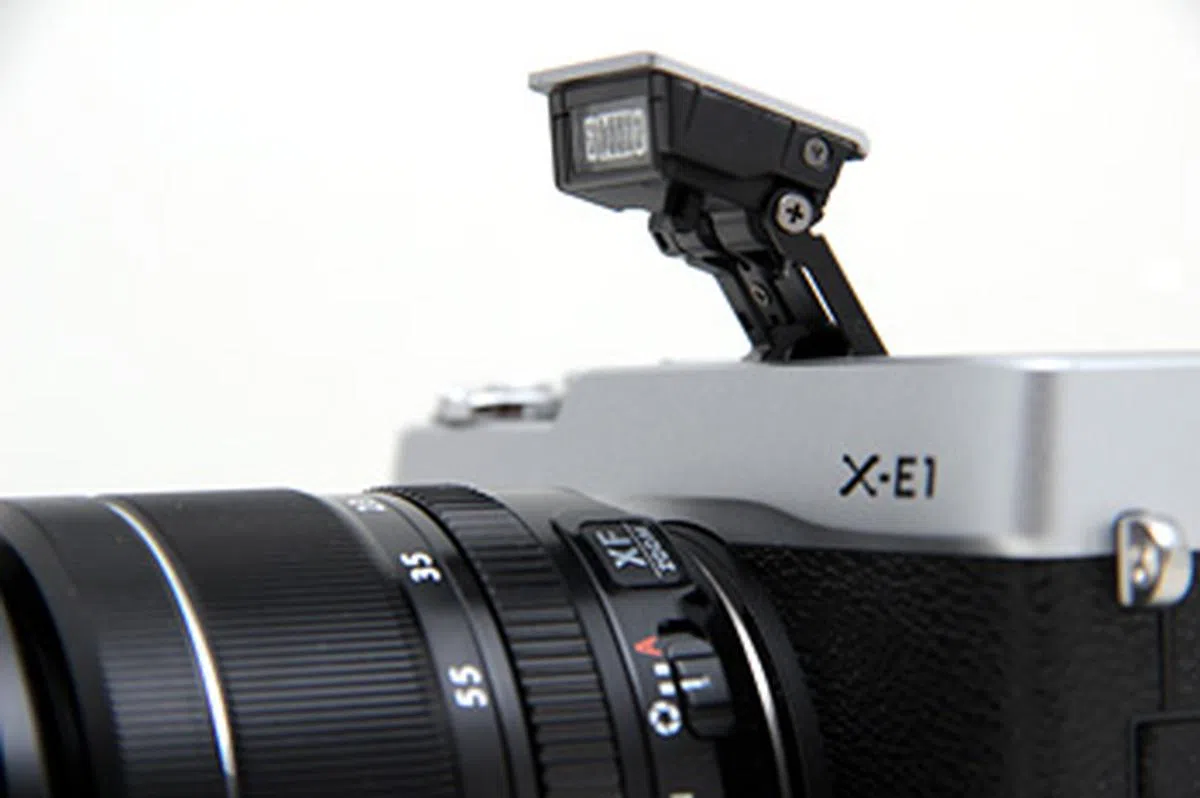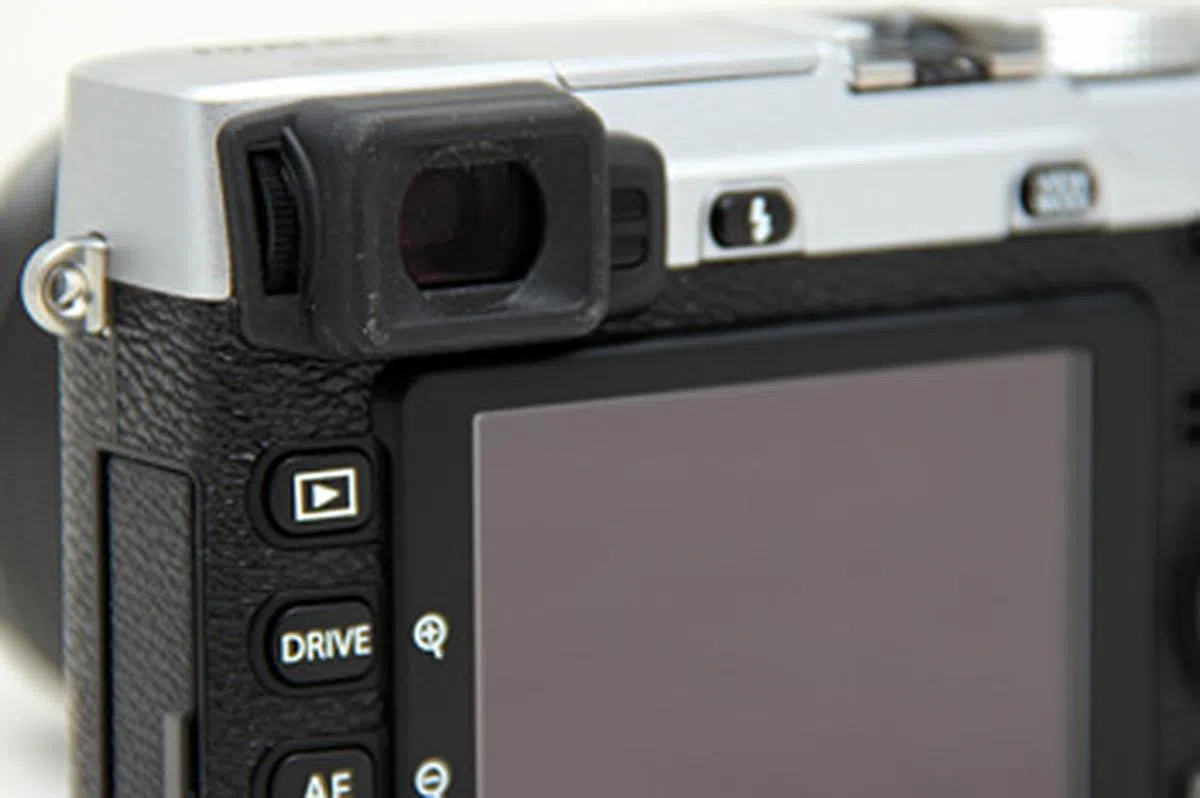Fujifilm X-E1 - A Concentrated Mirrorless Camera
Fujifilm has been on fire riding the retro/mirrorless combination. The X-E1 is a smaller, concentrated version of the X-Pro1, minus the optical viewfinder, bulk and price. It keeps the same unique X-Trans sensor, so performance should be the same - the question is, does it keep the bad of the X-Pro1 as well as the good?
By HardwareZone Team -

Introduction
Fujifilm has been on fire riding the retro/mirrorless combination. In 2011, the unique Fujifilm X100 combined an APS-C sensor inside a compact, rangefinder-inspired body with a fixed 35mm f/2 lens. It introduced an innovative hybrid viewfinder, which could switch between optical and electronic. Even though the camera had its quirks and was a niche product, it proved to be a hit with photographers and put the company back on the map.
In January of 2012, Fujifilm followed up with the X-Pro1, their first mirrorless system camera with interchangeable lenses. Fujifilm wisely launched the camera with three prime lenses, and introduced another innovation with the camera: the X-Trans sensor, which promised higher image clarity and less image noise.
Attractive as it was, the X-Pro1 had two problems. One was its sluggish autofocus, second was its high asking price. At S$2400 for the body alone, it was the most expensive mirrorless system camera on the market (if you left out the Leica M9). So here comes the X-E1.
The X-E1 is essentially a smaller, concentrated version of the X-Pro1. The main difference is that it loses the optical viewfinder, but keeps an electronic viewfinder (EVF). The EVF hasn't simply been ported over however, it's actually better than the one on the X-Pro1; it's slightly bigger and has a higher resolution. The X-E1 also comes with a built-in flash, which the X-Pro1 lacks. Internally, the X-E1 comes with the same 16MP APS-C X-Trans CMOS sensor and image processing engine as the X-Pro1, which means you should get the same level of image quality as the bigger and more expensive camera in a smaller and slightly less expensive package.
The one question is, did Fujifilm fix the sluggish auto-focus (AF) that plagued the X-Pro1? Fujifilm says it has overhauled their AF system to be better in the X-E1 (and also for the X-Pro1, but available as a firmware update). On paper, the X-E1 looks like solid value for money, but everything boils down to its performance in the real world and that's what we intend to find out in this review.
X-Pro1 | X-E1 | |
Processor | RCS1 & Co-processor | RCS1 & Co-processor |
Image Sensor | 16.3MP APS-C X-Trans CMOS | 16.3MP APS-C X-Trans CMOS |
Finder | Optical Viewfinder & 1.44M LCD EVF | 2.36M OLED EVF |
LCD | 3.0-inch, 1230k-dot resolution | 2.8-inch, 460k-dot resolution |
Internal Flash | N.A. | GN7 (ISO 200) |
Continuous Shooting | 6 frames per second | 6 frames per second |
Movie | 1080/24p | 1080/24p |
Battery Life | 300 frames (LCD), 1000 frames (OVF) | 350 frames (LCD/EVF) |
X Sync Terminal | Available | N.A. |
Shutter Speed Dial Lock | Available | N.A. |
External Microphone Jack | N.A. | Available |
Electrical Remote Release | N.A. | Available |
Price | S$2399 (body only) | S$1499 (body only), S$2099 (with XF 18-55mm kit lens) |

Design & Handling
The Fujifilm X-E1 is beautiful. Its looks are a straight derivative from the Fujifilm X100 to the X-Pro1 and before that from the rangefinders of old. It's classy and inspiring; inspiring you as the owner and inspiring looks from everyone else. We feel it's well-built, but there are some who complain about it feeling too plastic. Well, it's not any more plastic-feeling than a DSLR you'd get at the same price.
But this isn't a DSLR. The X-E1 invokes a more considered kind of shooting; not a camera you bring to snap bursts willy-nilly (although it can do that, up to six frames continuously). The X-E1 is quite a technical camera; it has its manual controls laid out on the body, which will certainly appeal to old-time camera users who know how to use them. But it might confuse beginners, especially when a button is accidentally knocked off course and images start looking weird.
The biggest difference between the X-E1 and the X-Pro1 is the removal of the optical viewfinder (OVF). It still comes with an electronic viewfinder (EVF), which might detract the purists in the camp. But it helps to reduce the cost of the camera. And the EVF is actually better than the one on the X-Pro1, it's slightly bigger (0.5-inch across compared to 0.47-inch), higher resolution (2.36 million dots compared to 1.44 million) and comes with a diopter (built-in versus none). Instead of LCD technology, it's using OLED. In the field, the EVF works pretty well, even with moving subjects. It's not as luxurious as an OVF, but if that's essential for you then there's always the X-Pro1.
Anyway, if you feel the lack of an OVF, X-E1 owners can always gloat about the inclusion of a built-in flash, which the X-Pro1 users have to do without.
 |  |

The physical controls give you immediate access to the most necessary controls - great if you know what you're doing and intimidating if you don't.
Just like how the internals of the X-E1 are mostly the same as the X-Pro1, the layout of the controls is mostly the same as well. On the top plate, the shutter speed dial loses the lock button, but keeps the very useful, customizable Function (Fn) button. The back of the camera also remains mostly the same; the Play button shifts to the left-most row of buttons, while the highly irritating indicator lamp on the X-Pro1 mercifully moves to the thumb-rest, away from the right eyes of left-eyed shooters.
The power switch is surprisingly easy to trigger; simply taking the camera out our fingers would brush against it and turn it on accidentally. But the shutter release inside it has a beautiful feel to it. Not just from its materials, there's a clear two-step trigger when you press downwards that's not too strict and not too loose.
Overall, the X-E1 experience is a positive one, more like a 'concentrated' X-Pro1 instead of a watered-down 'X-Lite'. But we feel that the camera misses a few opportunities to further evolve the line's handling. For instance, the self-timer is still buried within the menu, instead of belonging inside the Drive overlay menu. Auto ISO doesn't let you set a minimum shutter speed, which can be quite frustrating if you prefer shooting in Aperture Priority - the X-E1 seems to prefer lower ISO settings and slower shutter speeds.
Fujifilm still thinks that shooting in Burst drive mode (3/6 frames per second) is some kind of special event. When playing back your burst shots, you have to press an additional button to get into them, instead of being able to review them as part of your entire library of shot images. They're even named differently from the rest of your images, and there's really no good reason to do any of this.

Not much has changed between the X-Pro1 (left) and the X-E1 (right) (image not to scale).
Auto-focus Handling
Auto-focus is much improved (more on that in Image Performance section coming up), but AF point selection still isn't. There's a dedicated AF button, just like on the X-Pro1, but its use is limited. In AF Multi mode, where the camera automatically selects an AF point, it does nothing. It's only when you're in AF Area mode, where you choose the AF point manually, that the AF button activates AF point selection.
Imagine that the X-E1 stubbornly refuses to focus on your subject in AF Multi and you want to switch to AF Area to determine the AF point yourself. To switch AF modes, you have to press Q to go into the Quick Menu mode, select the AF mode icon and make the switch with the control dial. It takes too long to make the switch, and when you do chances are that your subject would have moved on.

The Quick Menu, activated by the Q button on the top right. You switch AF modes here, and open up AF point selection using the AF button on the left and the d-pad on the right.
When in AF Area, selecting AF points then takes a little bit of finger gymnastics. You have to press the AF button, activating the AF grid selection screen and then use the d-pad to select a point. These two buttons are on opposite ends of the camera, which makes changing AF points a two-handed operation, sometimes with your face up to the EVF, in the way of your fingers.
By the way, these are minus points we already raised with the X-Pro1.
If there's ever a positive demonstration of how a camera can handle it, it's Olympus' OM-D E-M5. A quick press on the d-pad lets you determine AF point manually, and pointing the AF point out of the AF grid brings it back to automatic area selection. It's a simple and fast method, one that Fujifilm could learn from.

f/8 at 36mm (35mm equivalent), 1/600 sec, ISO 800.
Image Performance
One of the exciting things about the Fujifilm X-Pro1 and X-E1 is how the cameras do away with the AA filter (also known as an optical low-pass filter). The AA filter in most digital cameras prevents nasty things like moiré artifacts from appearing in your photographs, but at the cost of some fine detail, so it always looks like there's a film of blurriness overlaid on your images.
A camera without the AA filter, like the X-E1, produces images which look that much clearer, that much sharper, with more clarity and crispness in the details. To be fair, if you don't pixel peep, you probably won't see the difference on Facebook. But if you do, and it's a fair bet that anyone who gets an X-E1 will, you'll certainly appreciate the difference.
The X-E1 can get rid of the AA filter because of its unique Fujifilm image sensor. Called the X-Trans sensor, it was first introduced with the X-Pro1. It uses a more random arrangement of RGB photosites than traditional image sensors, designed to mimic the random arrangement of film grain (more information and visual representation of this can be found in our earlier review of the X-Pro 1). The benefit of this unconventional arrangement is that the X-Trans sensor is less prone to moiré artifacts - they can still appear under certain conditions, but in all our shooting with the X-Pro1 and X-E1 we haven't seen any.
Another benefit is, of course, that high clarity of detail - the X-E1 scores a remarkable 2600 LPH (vertical and horizontal) on our resolution chart. It's also a solid low-noise performer, shooting at high ISO sensitivities that buck lesser cameras. With the X-E1, it's certainly possible to shoot up to ISO 6400 with easy confidence, the camera manages to keep noise down while retaining a high level of detail not yet seen in other mirrorless system cameras. Even ISO 12,800 is not complete rubbish.
Whether you'll like the X-E1's JPEG colors depends on whether you like the 'Fujifilm' look (or at least, the digital Fujifilm look). Colors have a blue-green shift, and the sensor's red channel appears especially sensitive; reds can appear quite intense in some images. The camera also has a tendency to let the whites blow, but to its credit they can often be recovered, even with JPEGs.

f/3.6 at 56mm (35mm equivalent), 1/140 sec, ISO 200.

The red channel seems especially sensitive. f/4 at 83mm (35mm equivalent), 1/30 sec, ISO 400.
The X-Pro1 had a problem with color smearing, where a color would run over and contaminate adjacent areas. Because of the way the X-Trans' RGB photosites are arrayed, there are areas with no adjacent alternative color. For example, in a conventional Bayer array sensor, a red photosite may be next to a green, then a red. On the X-Trans sensor, you might have a green photosite next to another green photosite before you get a red photosite. So the image processor has to try and guess what color's actually hitting the photosite with less information to work on.
Color smearing doesn't appear in all images, but there are samples of it online. We haven't seen it in our own images, but we have seen what we can only describe as odd edge glows, where a halo or double-edge appears in certain subjects. It's not exactly purple fringing, as the glows aren't purple, and where we shot back-lit subjects there was no evidence of purple fringing. Again, it doesn't happen all the time, and you might not even notice it if you don't zoom into your picture. But if you do, or if you print them large, you might be able to spot them, and it's a strike against what is otherwise very good image quality.

100% crop, an example of an 'edge glow'. f/2.8 at 27mm (35mm equivalent), 1/280 sec, ISO 200.

100% crop, another example of an 'edge glow'. f/4 at 76mm (35mm equivalent), 1/85 sec, ISO 200.

100% crop, no evidence of purple fringing when we shot backlit with the same 18-55mm kit lens. f/4 at 76mm (35mm equivalent), 1/85 sec, ISO 200.
Photographers who shoot in raw will also want to note that the X-Trans sensor's RAW conversion in apps other than Fujifilm's Silkypix seem to have problems getting rid of the color smearing. If you're someone who works exclusively in RAW and Adobe, the X-E1 might present a workflow hiccup for you (ChromaSoft has a very detailed, very technical report about this).
If you've read our X-Pro1 review, we said that its Achilles' heel was its sluggish auto-focus. In a pre-release briefing, Fujifilm told us that they put in a lot of effort to improve the X-cameras' AF and it shows in the X-E1. It's certainly snappier than the X-Pro1 when it first launched, it's able to find and lock onto subjects with reasonable speed. That said, it's also not state of the art fast in a year when we have Olympus, Panasonic and Nikon providing ultra-fast auto-focus systems that can even recognize faces (and in the Olympus' case, even recognize eyes – sometimes).
It also seems to prefer center focus, and sometimes will confirm lock when it hasn't really gotten one. Continuous AF is only center focus, and like on most mirrorless system cameras except Nikon's, is best left alone. It sounds bad, but the X-E1's AF is usable for photographers who shoot at a considered pace.
Sample Photographs
These are sample photographs shot with the Fujifilm X-E1. The photos have not been post-processed and are copyright to SPH Magazines. They are provided for your reference only and we ask that you do not reproduce them elsewhere. Click for full-resolution images.

f/8 at 49mm (35mm equivalent), 1/30 sec, ISO 200.

f/5.6 at 27mm (35mm equivalent), 1/34 sec, ISO 200.

f/5.6 at 83mm (35mm equivalent), 1/150 sec, ISO 400.

f/4 at 83mm (35mm equivalent), 1/14 sec, ISO 6400.

f/3.6 at 35mm (35mm equivalent), 1/38 sec, ISO 12800.

Conclusion
The Fujifilm X-E1, as a concept, is irresistible. Whoever drew up the design spec for the X-series was either a photographer, or really understood them. As the furthest evolution of the X100 to the X10 and the X-Pro1, the X-E1 and the XF lenses stand as a testament to knowing what photographers want: Small body, large sensor, access to controls, fast lenses and beautiful image quality.
In translating that spec to reality though, some things seem to have been lost in translation. AF performance has improved, but not yet to the level of today's best mirrorless cameras, i.e. current generation Micro Four Thirds or Nikon 1 cameras (at this point, we think Fujifilm should just license the technology from somebody). Changing AF points is a chore, just as it's always been.
The X-Trans sensor giveth and taketh away. It provides exceptional clarity, the kind you can't get with an AA filter in your way, plus exceptional high ISO/low noise performance which easily ranks it among the cream of the APS-C sensor crop. At the same time however, color smearing and edge glows (which might be part of the same phenomena) can happen, so you'll need to decide if the increased acuity is worth the potential trade-off. The RAW image workflow also presents a challenge; if you shoot RAW and work in anything other than Fujifilm's Silkypix, then you might have to consider how best to process your images.
So while we think the X-series is one of the most promising mirrorless systems for photographers, we also think it still has some way to go. The X-E1 is certainly a fine camera which will produce a lot of beautiful images, but it's not perfect by any means. Its faster AF speeds over the X-Pro1 make it an easier camera to love, but it's still a camera for a considered, slower pace of shooting than something with a wicked fast AF like the Olympus E-M5 or a DSLR camera.
And the camera is certainly not for someone who wants to shoot video, while it can shoot 1080/24p video with stereo, you'll notice that there are no video controls placed front and center. This is really a stills camera geared for the stills photographer.
Now, price. The X-E1 is cheaper than the X-Pro1, but it's not cheap by any means. The X-E1 with the XF 18-55mm kit lens will set you back S$2099, while the body alone is S$1499. The X-Pro1 body alone was S$2399. Lest you think that's a massive discount, consider the competition. An XF prime lens will cost you S$899 per lens. If you go body alone with a 35mm f/1.4 prime, that's a retail price of S$2398. Not exactly competitive in a landscape full of mirrorless system cameras going for less. If the retro look and AA filter-less APS-C sensor appeals to you, then maybe. If not, there are other cameras that can get you, if not as good, but good enough image quality for less money.
While using the X-E1, we never felt at any point that it was a diluted version of the X-Pro1. Rather, the X-E1 feels to us like a smaller, concentrated version of its more expensive predecessor, with all its strengths as well as (some) weaknesses.
Our articles may contain affiliate links. If you buy through these links, we may earn a small commission.



